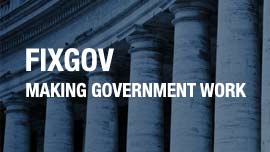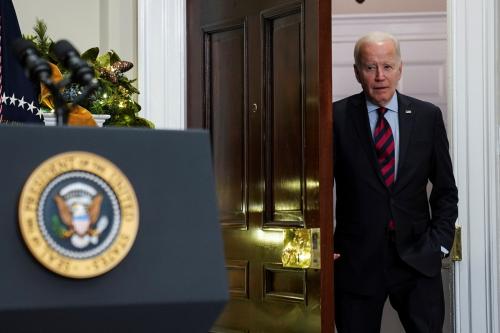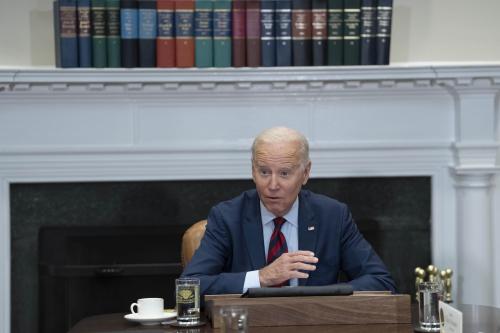This post was updated on 04/22/21 to correct the vacancy counts during the George H. W. Bush administration.
News reports say that President Biden will soon “make his mark” on the federal judiciary with a “raft of nominees.” Two important “marks” are the number of appointees and what Senate Judiciary Chair Richard Durbin called “rebalancing”—changing the balance of Republican and Democratic appointees. (Biden has also emphasized demographic and pre-appointment vocational diversity.)
In short, here’s the situation that Biden faces, as of March 17, 2021: Biden will have fewer vacancies than did President Trump and thus not as many appointments. The closely divided Senate will make confirmations arduous, especially if Republicans vote against Biden nominees in numbers similar to Democratic votes against Trump nominees. Biden should be able to bolster the Democratic-appointee majority on the district courts. But he will still have difficulty changing the Republican-appointee majority on the courts of appeals.
Taking these one at a time:
Estimating Biden’s judicial opportunities
President Carter holds the four-year record for most appointments (261, 59 of them to the courts of appeals), followed by Trump (234, 54 to the courts of appeal). Only two other presidents, Clinton and W. Bush, topped the 200 mark—and just barely. Carter and Trump racked up the numbers they did because they had a lot of vacancies to fill and compliant Senates to help fill them.
(A vacancy is a statutory judgeship with no incumbent. Judges create vacancies when they leave “active status,” almost always by retiring to “senior status” (continuing to do some judicial work) or retiring altogether (in both cases, retaining their salary). A few judges create vacancies by “resigning” (their age and service years make them salary-ineligible); appointment to another judgeship; and death. And Congress can enact judgeship bills, which create additional judgeships that are vacant until the president appoints judges to fill them.)
A 1978 judgeship bill alone gave Carter 96 vacancies. Trump had no judgeship bill but inherited the second-largest number of vacancies of his recent predecessors (106, second only to Clinton’s 109, many of them created by a 1990 judgeship bill). Biden, by contrast, inherited only 46 vacancies—all but two in district courts, reflecting Republicans’ Ahab-like pursuit of court of appeals confirmations.
By the end of March, Biden will still have fewer vacancies than all recent predecessors except Reagan, Bush 1, and perhaps Obama.
Vacancies at the end of March, first year
|
1981 Reagan |
1989† H.W. Bush |
1993 Clinton |
2001 Bush |
2009 Obama |
2017 Trump |
2021* Biden |
|
| Cts of Appeal | 7 | 11 | 17 | 30 | 15 | 19 | 7 |
| District Cts** | 35 | 34 | 92 | 67 | 55 | 97 | 61 |
| TOTAL | 42 | 45 | 109 | 97 | 70 | 116 | 68 |
* as of March 17, 2021; ** includes Court of International Trade; excludes term-limited territorial judges; † Updated after original publication of this piece.
How many more vacancies might Biden expect over four years? First, 24 district and five circuit judges have announced their intention to leave active status in the near future.
Second, additional retirement-eligible judges who are still in active status will retire. Just on the courts of appeals, 56 judges currently in active status are eligible to retire on salary but have not done so. Seventy-three will be eligible by mid-June 2024.
As a matter of simple arithmetic, the court of appeals alone could see at least 85 Biden appointees:
| Court of Appeals vacancies | 7 |
| Announced future appellate vacancies | 5 |
| Additional appellate judges retirement-eligible by June 2024 | 73 |
| TOTAL | 85 |
And the 85 doesn’t include active status judges who might resign without waiting for retirement eligibility, or get appointed to the Supreme Court, or die.
But this arithmetic is outer-limits. Most important, not all retirement-eligible judges will retire. (Of the 56 retirement-eligible appellate judges, 23 have been eligible for at least 20 years.) In the four most recent presidential administrations’ first four years, from 24 to 39 court of appeals judges left active status.
Even if 39 appellate judges created vacancies for Biden (as they did for Trump), Biden would have about half the arithmetic pipedream of 85 vacancies.
What obstacles will Biden face in the Senate?
Carter’s and Trump’s court of appeals confirmation rates were over 90 percent, remarkable in Trump’s case, given the 70-80% range of his most recent predecessors. Carter’s district rate was also over 90 percent. Trump’s was 85 percent, roughly similar to his more recent predecessors.
But Democrats opposed Trump nominees more aggressively than had opposite-party senators in previous administrations. Of Trump’s 54 circuit judges, 37 had at least 40 negative votes, as did 40 of his 177 district judges. Over Obama’s full eight years only six of his 55 circuit judges had 40 or more negative votes; only 13 of his 272 district judges had 40 or more.
Republican senators may use this opposition as pretext for similar resistance to Biden’s nominees. In a 50-50 Senate, cohesive Republican opposition and a few maverick Democratic senators could doom confirmations.
And if Republicans gain the Senate majority—through vacancies in Senate Democratic ranks, for example, or the 2022 midterms—confirmations will become even dicier. In the Obama administration’s final two years, Majority Leader McConnell held the confirmation rate at 31%. In Reagan’s, Clinton’s, and Bush’s final two years, opposite-party Senate majorities confirmed from 68% to 80% of nominees. (That 31%confirmation rate in 2015-16 helps explain the many vacancies that Trump inherited.)
Will Biden be able to “rebalance” the judiciary?
Presidents also mark their judicial impact by shifting the party-of-appointing president balance. Which party appointed judges helps predict (emphasis on “helps”) judges’ votes in ideologically charged cases, as seen most recently in an examination of the decisions of district appointees, Kennedy through Trump.
Whatever balancing Biden achieves will depend on the number of available vacancies, how many he can fill, and whom he replaces. Biden’s replacing a Democratic-appointed incumbent will seat a younger judge but not change the balance.
District courts: Although Trump shifted the appointing-party balance on the courts of appeals from majority Democratic to majority Republican appointees, he didn’t change it on the district courts. There are 311 Democratic-appointed district judges in active status and 310 Republican appointees; the Democratic ranks are artificially low, having been reduced by post-Inauguration retirements. And 52 of the 83 current and announced district vacancies are or were occupied by Republican appointees, so Biden has a clear opportunity to bolster the proportion of Democratic appointees.
Courts of appeals: On the courts of appeal, however, 53 percent of the 179 judgeships are occupied by Republican appointees.
Every recent president has increased the proportion of active-status court of appeals judges appointed by that president’s party, although the size of the increase depends on the number of appointments and who they replace—Carter’s 24 percent increase was the largest, due to the 35 new circuit seats that Congress gave him in 1978.
That anomaly aside, Trump achieved the greatest increase, from 40 percent when he took office to 54 percent when he left. Although 65 percent of his appointees replaced Republican appointees, the sheer number of his appointees was enough to change the balance dramatically. Put differently, had Trump appointed not 54, but rather 30 judges to the courts of appeal (as did Obama in his first four years), the proportion of Republican appointees would have been unchanged. (Obama’s 30 first-term appointees changed the proportion of Democratic appointees by seven percent, but Obama alone among recent presidents replaced more other-party than own-party incumbents.)
Thus, the challenge facing the Biden administration in its efforts to rebalance the party-of-appointing president composition of the courts of appeal, comes back to number of appointees as well as whom those appointees replace. Of the 12 current or announced vacancies, nine are/were Democratic appointees. Democratic appointees also constitute 31 of the 56 retirement-eligible circuit judges.
How the courts of appeal might “rebalance”
The table shows the make-up of the courts of appeal in mid-March 2021—arranged from strong Democratic-appointee majority to strong Republican-appointee majority. (The numbers show active-status judges only, even though senior and visiting judges also decide cases, albeit less frequently.)
The DC Circuit’s court, for example, has four Republican appointees in active status, six Democratic appointees, and one vacancy (created by Attorney General Garland). The final two columns show that two judges in active status—one a Republican-appointee, the other a Democratic-appointee—are among the 56 retirement-eligible active-status judges.
Courts of appeal as of mid-March 2021
| Judges by party of appointing president | Retirement-eligible judges | |||||
| Republican | Democrat | Vacant* | Total | R-appts | D-appts | |
| 1st | 1 | 4 | 1 | 6 | 1 | 2 |
| FED | 4 | 8 | 0 | 12 | 3 | 2 |
| 4th | 6 | 9 | 0 | 15 | 3 | 4 |
| DC | 4 | 6 | 1 | 11 | 1 | 1 |
| 9th | 13 | 16 | 0 | 29 | 3 | 9 |
| 10th | 5 | 5 | 2 | 12 | 1 | 0 |
| 3rd | 8 | 6 | 0 | 14 | 1 | 2 |
| 11th | 7 | 5 | 0 | 12 | 0 | 2 |
| 2nd | 6 | 5 | 2 | 13 | 0 | 2 |
| 6th | 11 | 5 | 0 | 16 | 2 | 4 |
| 5th | 12 | 5 | 0 | 17 | 4 | 2 |
| 7th | 8 | 2 | 1 | 11 | 3 | 1 |
| 8th | 10 | 1 | 0 | 11 | 3 | 0 |
| Judges | 95 | 77 | 7 | 179 | 25 | 31 |
| % of Judgeships | 53% | 43% | 4% | |||
| % of Active Judges | 55% | 45% | ||||
| * Does not include those who have announced they will leave active status. Five Democratic appointees have done so. | ||||||
Biden has the chance to strengthen the Democratic-appointee majorities on courts that now have strong and event modest Democratic-appointee majorities (and appoint younger judges who will serve longer than would have the Democratic appointees they replace). Of courts with slight Republican-appointee majorities, only the Second Circuit’s now has the numbers to allow a change—and given that court’s importance, appointment battles may be intense. On the other hand, the Fifth through Eighth circuits’ courts are likely to maintain their Republican-appointee majorities regardless of what Biden does. To take the most obvious example—the Eighth circuit’s court—even if Biden could replace the three eligible Republican appointees, the new balance would be 7-4-0.
More generally, Republicans will seek to preserve and Democrats to reverse the mark Trump left on the judiciary. As for the courts of appeals, at this point the numbers suggest advantage: Republicans.
Data for this post come from the “History of the Federal Judiciary” page of the Federal Judicial Center (fjc.gov), uscourt.gov., and my own data sets.
The Brookings Institution is committed to quality, independence, and impact.
We are supported by a diverse array of funders. In line with our values and policies, each Brookings publication represents the sole views of its author(s).








Commentary
Can Biden ‘rebalance’ the judiciary?
March 18, 2021